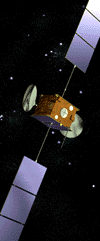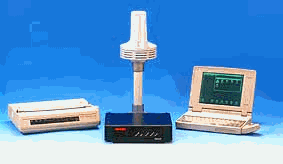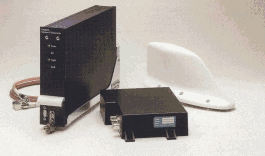

![]() Mike Serov (17) tells about one of global Space projects.
Mike Serov (17) tells about one of global Space projects.

INMARSAT (International Maritime Satellite Association ) was created in 1979.
There were 48 countries in it that time. INMARSAT was the first world's global mobile satellite communications operator and is still the only one to offer a mature range of modern communications services to maritime, land-mobile, aeronautical and other users.
Starting with a user base of 900 ships in the early 1980s, it now supports links for phone, fax and data communications at up to
64 kbit/s to more than 250 000 ships, vehicles, aircrafts and portable terminals. That number is growing at several thousands a month.
INMARSAT Ltd is a subsidiary of the Inmarsat Ventures plc holding company. It operates a constellation of
geo-stationary satellites designed to extend phone, fax and data communications all over the world. The constellation comprises five third-generation satellites backed up by four earlier spacecraft. The satellites are controlled from
INMARSAT's headquarters in London, which is also home to INMARSAT Ventures as well as the small IGO created to supervise the company's public-service duties for the maritime community (Global Maritime Distress and Safety System) and aviation (air traffic control communications).
INMARSAT has regional offices in Dubai, Singapore and India. Today INMARSAT system is used by independent service providers to offer a range of voice and multimedia communications.

Users include ship owners and managers, journalists and broadcasters, health and disaster-relief workers, land transport fleet operators, airlines, airline passengers and air traffic controllers, government workers, national emergency and civil defence agencies, and peacekeeping forces. The INMARSAT business strategy is to pursue a range of new opportunities at the convergence of information technology, telecoms and mobility while continuing to serve traditional maritime, aeronautical, land-mobile and remote-area markets. Keystone of the strategy is the new INMARSAT I-4 satellite system, which from 2005 will support the INMARSAT Broadband Global Area Network (B-GAN) - mobile data communications at up to 432 kbit/s for Internet access, mobile multimedia and many other advanced applications.
Coverage map.
On the picture 1 you may see contemporary situation of INMARSAT's satellites, zone of service and coastal stations. As you see
INMARSAT guarantee accession if only one satellite between 65� n.l. and 65�
s.l.

Satellites.
INMARSAT's primary satellite constellation consists of four Inmarsat-3 satellites in
geo-stationary orbit. Between them, the main ("global") beams of the satellites provide overlapping coverage of the whole surface of the Earth apart from the poles. So, thanks to
INMARSAT, it has become possible to extend the reach of terrestrial wired and cellular networks to almost anywhere on Earth. A
geo-stationary satellite follows a circular orbit in the plane of the Equator at a height of
35 600 km, so that it appears to hover over a chosen point on the Earth's surface. Three such satellites are enough to cover most of the
Globe, and mobile users rarely have to switch from one satellite to another. Other mobile satellite systems use larger numbers of satellites in lower,
non-geo-stationary orbits. From the user's point of view, they move across the sky at a comparatively high speed, often requiring a switch from one satellite to another in mid-communication and risking the possibility of an interrupted call. A call from an
INMARSAT mobile terminal goes directly to the satellite overhead, which routes it back down to a gateway on the ground called a
Land Earth Station (LES). From there the call is passed into the public phone network. The Inmarsat-3 satellites are backed up by a fifth Inmarsat-3 and four previous-generation Inmarsat-2s, also in
geo-stationary orbit. A key advantage of the Inmarsat-3s over their predecessors is their ability to generate a number of spot-beams as well as single large global beams. Spot-beams concentrate extra power in areas of high demand as well as making it possible to supply standard services to smaller, simpler terminals.

Inmarsat-2: purpose built quartet.
Launched in the early 1990s, the four second-generation satellites were built to INMARSAT specification by an international group headed by British Aerospace (now BAE Systems). The three-axis-stabilized Inmarsat-2s were designed for a 10-year life. Inmarsat-2 F1 was launched in 1990 and is now located over the Pacific as a back-up for Inmarsat-3 F3. F2, launched in 1991, is over the western Atlantic, providing leased capacity and backing up Inmarsat-3 F4. Also orbited in 1991, F3 is stationed over the Indian Ocean, backing up Inmarsat-3 F1. The fourth Inmarsat-2 was launched in 1992 and is used to provide leased capacity over the western Atlantic.
Inmarsat-3: a story of spot beams.
Launched in 1996-8, the Inmarsat-3s were built by Lockheed Martin Astro Space (now Lockheed Martin Missiles & Space) of the USA, responsible for the basic spacecraft, and the European Matra Marconi Space (now Astrium), which developed the communications payload. The Inmarsat-3 communications payload can generate a global beam and a maximum of seven spot-beams. The spot-beams are directed as required to make extra communications capacity available in areas where demand from users is high.Inmarsat-3 F1 was launched in 1996 to cover the Indian Ocean Region. Over the next two years F2 entered service over Atlantic Ocean Region-East, followed by F3 (Pacific Ocean Region), F4 (Atlantic Ocean Region-West) and F5 (back-up and leased
capacity).
Inmarsat-4: gateway to broadband.
Responding to the growing demand from corporate mobile satellite users for high-speed Internet access and multimedia connectivity,
INMARSAT is now building its fourth generation of satellites. The company has awarded European spacecraft manufacturer Astrium a
US $700 million contract to build three Inmarsat I-4 satellites. Astrium is the European company that includes the former Matra Marconi Space, which built the Inmarsat-2 satellites and the payload for the Inmarsat-3s. The job of the satellites will be to support the new Broadband Global Area Network (B-GAN), to be introduced in 2005 to deliver Internet and intranet content and solutions, video on demand, videoconferencing, fax, e-mail, phone and LAN access at speeds up to
432 kbit/s almost anywhere in the world. B-GAN will also be compatible with third-generation (3G) cellular systems. The satellites will be 100 times more powerful than the present generation and B-GAN will provide at least 10 times as much communications capacity as today's
INMARSAT network. The spacecraft will be built largely in the United Kingdom. The bus will be assembled at Astrium's factory in Stevenage and the payload in Portsmouth. The two sections will then be united in Toulouse, France, together with the US-built antenna and German-built solar arrays.
How to use Inmarsat.
Series of client standards have created for working in INMARSAT system. This is Inmarsat-phone mini-M, Inmarsat-A, Inmarsat-B, Inmarsat-C, Inmarsat-D/D+, Inmarsat-M, Inmarsat-E, Inmarsat Aero-H, Inmarsat Aero-I, Inmarsat Aero-L. The most useful standard is Inmarsat-C. Arrangement for this standard you may see on
the picture below. This arrangement intend for automatic collect information about situation of vessel or other transport. This standard service transfer electronic messengers to Internet. Volume of messenger may consider
32 Mb of information. Sea-station services transfer/reception information with speed 600 b/s. It is possible with such nets as: TELEX, X.25, X.400, Internet E-mail, FAX and also with all
INMARSAT standards. But voice connect is impossible. The view of client arrangement you can see at
this picture.

Typical set for Inmarsat-C consist of transfer/reception-station, small size aerial, special computer for manager station and view information, storage battery and printer.
Also exist air-arrangement for Inmarsat-C standard. This arrangement use on airplanes. The view of it you can see at
this picture.

But also exists so much different arrangement for all INMARSAT standards, that write about all of them is so long and boring. And I decided to view you
some pictures with this arrangements. The best property of all arrangements is their small size and comfort during
using.
The new solution in client Inmarsat systems.
Fleet F33 and F55 are the latest additions to INMARSAT's Fleet family of maritime services, designed to equip smaller vessels with voice, e-mail and secure Internet access. Crews on small and medium-sized boats will now be able to run a mobile office at sea, complete with telephone, e-mail and Internet access, thanks to two new services from
INMARSAT.

Called Fleet F33 and F55, the new services follow the successful launch of the first in the family of
INMARSAT Fleet services, F77, in April this year. Together, Fleet F33, F55 and F77 provide high-quality mobile voice and flexible data communications services for the maritime industry. Fleet F55 and F33 allow smaller vessels to benefit from voice, e-mail, secure Internet and intranet access, plus high-quality fax services. The data rates available through Fleet F33 and F55 mean that a new, wider range of applications is available to the smaller vessel market. Maritime-specific information, such as sea and weather charts, can be made available online and updated in real time. Users can also enjoy the benefit of reliable, easy access to e-mail whenever and wherever needed.
The benefits of Fleet F33, due for launch in early 2003, include:
1.Clear, digital voice available virtually globally in all four of the INMARSAT Ocean Regions.
2.Two distinct data services available in INMARSAT spotbeam areas depending on terminal version
3.Enhanced 9.6 kbit/s data offering high performance throughput, plus Inmarsat Mobile Packet Data, offering 'always connected' capability where users pay for the amount of data transferred and not the time spent online.
4.Small, lightweight antenna (similar to mini-M), offering increased ease of supply and installation.
Fleet F55's data service, on the other hand, will utilize the spotbeams on
INMARSAT's satellites, providing up to 64 kbit/s Mobile ISDN or Mobile Packet Data in those areas of the world covered. F55 voice services use the global beam to provide worldwide coverage.
The benefits of Fleet F55, due to be launched in early 2003, include:
1.Clear, digital voice available in all four INMARSAT Ocean Regions.
2.Two distinct services available in INMARSAT spot-beam areas: 64 kbit/s Mobile ISDN providing high-quality voice, group 4 fax, or high-speed voice band data service; or Mobile Packet Data.
3.An "always on" Internet Protocol (IP) service, with charges by the amount of data sent and received, not the time spent online. This is very attractive for smaller volumes of data or interactive data sessions.
4.Relatively small lightweight antenna offering easy installation for smaller
vessels.
Good connections.
To accommodate the rapidly growing demand for new mobile data communication services, Telenor Satellite Services has enhanced the capabilities of its three land earth stations (LESs) that provide global communications via the
INMARSAT satellite system. Located at Eik (Norway), Santa Paula (California, USA) and Southbury (Connecticut, USA), the LESs serve as a link between terrestrial communications networks and the
INMARSAT satellites. INMARSAT company decided to upgrade earth stations.
Upgrades to the earth stations include the following:
1.New high-speed data communications equipment to accommodate the increased demand for mobile high-speed data services. This allows Telenor to continue providing Internet access, video conferencing and large file transfers to maritime and aeronautical companies using
INMARSAT's Fleet and Swift64 services.
2.New Lucent telecommunications equipment to make broadband networking easier for customers with SS7, a widely-used telephone switching protocol. This enhancement shortens call set-up time and allows Telenor to route calls through its global network more efficiently, resulting in reduced costs to customers.
3.New 16-metre satellite antenna in Norway, which will operate on INMARSAT's existing and future fourth generation satellites. As well as providing increased efficiency of satellite resources, this will help pave the way for emerging satellite communications technologies that permit faster speeds and increased throughput with smaller satellite terminals.
4.Enhancements to the power, signal tracking and amplifying, environmental controls and security systems in the Southbury, Connecticut LES, making the facility one of the most up-to-date and multi-functional earth stations in the satellite industry.
Conclusion.
I have been working with my article for some weeks. While I have collecting information about
INMARSAT system I decided that it's very useful. Because INMARSAT make transferring and reception information very easy and fast. But best property of it system is that client can get necessary information in any place all over the world.
This is one of the basic systems for globalization processes.
Sources of information.
1. www.inmarsat.com - official web-page of
INMARSAT system.
2. www.sdt-coonect.ru - article about
INMARSAT standards.
3. article by Akimov A. A. about INMARSAT.
4. www.informost.ru - some information about
INMARSAT.
5. www.geomatics.ru - some information about
INMARSAT.